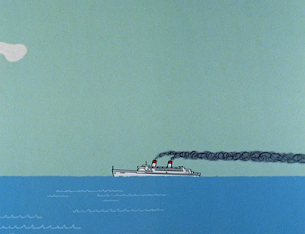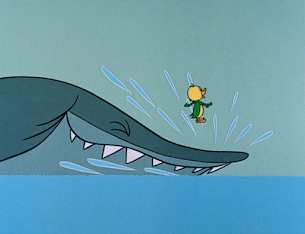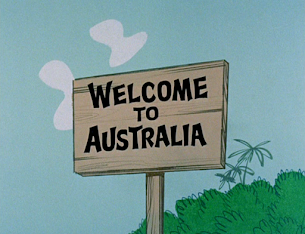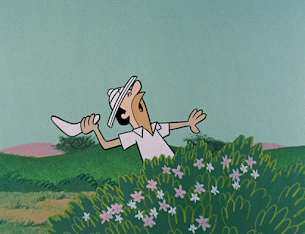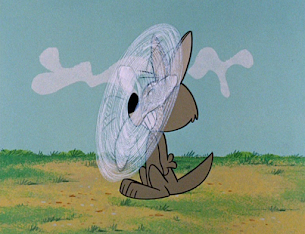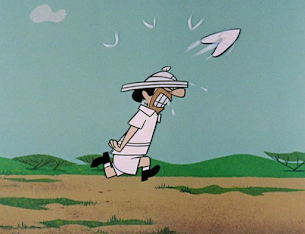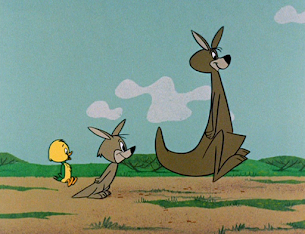Joe Barbera was a man of many talents. He was quick sketch artist and an able story man. He was a super salesman of the studio’s product (he could sell a network on a cartoon series even when he didn’t know exactly what he was pitching). And he was praised by actors as being an excellent voice director, though he could be tough.
And he seems to have had a great deal of patience.
Reels of early Hanna-Barbera voice sessions (they were recorded on Ampex tape machines) may be buried somewhere, so about the best we can do to give you an idea of what they were like is pass along this story from the Pittsburgh Post-Gazette, August 9, 1960.
Alan Dinehart was hired in April 1960 as an Associate Producer of the Flintstones. He had been an actor and a writer, so it’s no surprise he did a little bit of uncredited voice work on the series. Jerry Mann had met Bill Hanna and Joe Barbera at MGM in the ‘40s where he supplied voices on a few of the Tom and Jerry cartoons that needed them. His acting career went back to his childhood in the early 1920s; he performed a solo act at the pinnacle of vaudeville, the Palace in New York, in 1925. You can read more about him in this post.
With Arf and Aroo-o-o
By ARNOLD ZEITLIN
HOLLYWOOD
JOE BARBERA, curly haired, handsomely tanned, studied the control booth dials, glanced admiringly at the cartoon sketches in his hand and waved a finger at six actors under glass in a Sunset Blvd. recording studio. With calm precision, the actors stepped to three hanging microphones and, in concert, delivered intensely:
“Arf, arf, arf . . .”
“Ruff, ruff, ruff . . .”
“Bowwow, bowwow, bowwow . . .”
“Yeep-yeep, yeep-yeep, yeep-yeep . . .”
“Woof, woof, woof . . .”
“Ar oo-o-o-o, ar oo-o-o-o, ar oo-o-o-o . . .”
Barbera's finger flicked impatiently. The doggie din died.
“I can see,” Barbera said dryly, “none of you ever were in a dog pound.”
● ● ●
IT WAS 11 p. m. To an uninitiated observer it appeared to be the place where Hollywood actors bark off their daily frustrations. But Barbera and his six reasonably human actors had been penned in the small glass-walled studio for nearly four hours recording another episode of the new television series railed “The Flintstones.”
“The Flintstones” is widely ballyhooed as television's first cartoon series for adults. Each episode costs $65,000 to make, nothing: to bark at. You’ll see it Friday at 8:30 p. m. on WTAE, Channel 4, starting Sept. 30.
Each half hour cartoon will tell a tale of Fred and Wilma Flintstone, their neighbors Barney and Betty Rubble, both typical couples—with one difference. They live in the Stone Age. It's sort of "I Love Lucy" with dinosaurs.
● ● ●
ALAN REED and Jean Vander Pyl supply the Flintstones’ voices. The neighbors are Bea Benaderet, a veteran of the "Burns and Allen" show, and Mel Blanc, best known for his crunchy “What's Up, Doc!” greeting as Bugs Bunny.
The show comes from the Joe Barbera-Bill Hanna animation factory which also manufactures "Huckleberry Hound."
The two couples, plus actors Alan Dinehart and Jerry Mann, were in the soundproof studio making the sound track. Barbera was directing. He ordered another round of barking (the plot had something to do with Barney’s being hypnotized into thinking he was a dog and his landing in the pound).
“Seems like we have less dogs this time,” said Barbera, puzzled. More barking.
“Okay (Barbera, now perturbed) who was that fourth dog from the end?”
“ARE THESE all male male dogs?” interrupted Miss Vanderl Pyl, a jolly redhead.
“I don’t know if they let them mix in dog catcher wagons,” mused Barbera.”We don't want any lady dogs.”
“Surely,” said Miss Benaderet, mildly, “you can use a couple of bitches?”
Barbera let the suggestion slide. Miss Pyl, giggling, persisted doggedly:
“Could one be a French poodle?”
● ● ●
BLANC, SPEAKING for two dogs and the pound keeper in addition to his regular role, broke up in the middle of a bark. “What’s the matter?” said Barbera.
Gazing at the clock, Blanc panted, “I’m stir crazy.”
Barbera kept at them. More barking, accompanied by Barbera’s hounding. (“You’re a little, too frantic . . . you sound too hysterical”). He warned Blanc not to sound too old a dog catcher and the dour little man snapped back, “What’s wrong with an old dog catcher?”
● ● ●
AN AD AGENCY man wandered in the control booth. He announced he had found an elephant needed for a commercial film at a farm in the San Fernando Valley. “We drove up the dirt road to a steel gate which hail this huge sign, ‘Beware of Dog,’” he said, slinking his head over the vagaries of Hollywood life, “and not ten feet away was an . . an . . elephant.”
Soberly, Barbera looked up from his script and dials and said, “Did it bark?”
● ● ●
THE FINAL LINK of the script was reached. Barney, supposedly cured of his dogginess, picks up a package in his mouth and trots off. Blanc delivered the effect by talking with, his thumb in his mouth.
Barbera played back the line over the loudspeaker. Then he directed, “I want that last line with a little less finger.”
He got it. The session was over. Another "Flintstones" was born.
● ● ●
ON THE way out, a visitor hesitantly asked Miss Benaderet:
“Don’t you feel odd barking and all this foolishness . . . ?”
“Oh, no, silly,” she said, “It’s wonderful, Just like the old radio days.”
The visiting newsmen proceeded to walk up Sunset Blvd. Meanwhile, Miss Benaderet climbed into her cream colored Caddie and roared off.
Silly? Cadillac? There seemed to be but one answer:
Arf, ruff, bowwow, yeep yeep, woof and aroo-o-o-o-o.






























































































































